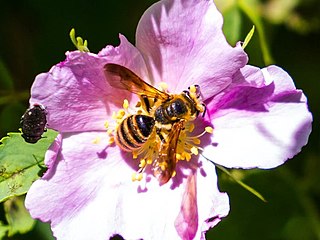
Hoplitis anthocopoides is a species in the family Megachilidae, in the order Hymenoptera . The distribution range of Hoplitis anthocopoides includes Africa, Europe, Northern Asia, and North America.

Andrena crataegi, the hawthorn miner bee, is a species of miner bee in the family Andrenidae which is in the order Hymenoptera. Another common name for this species is hawthorn andrena. It is found in North America.

Andrena krigiana is a species in the family Andrenidae, in the order Hymenoptera. The species is known generally as the "dwarf-dandelion andrena". It is found in North America.
Andrena palpalis is a species of mining bees in the family Andrenidae. It is found in Central America and North America.

Bombus vandykei, the Van Dyke's bumble bee, is a species of bumble bees in the family Apidae. It is found in North America.
Anthophora fedorica is a species of anthophorine bee in the family Apidae. It is found in North America.
Lasioglossum petrellum is a species of sweat bee in the family Halictidae.
Conanthalictus bakeri is a species of sweat bee in the family Halictidae. It is found in North America.

Colletes thoracicus, the rufous-chested cellophane bee, is a species of cellophane or plasterer, masked, or fork-tongued bee in the family Colletidae. It is found in North America.
Habropoda pallida, known generally as the pallid habropoda or white-faced bee, is a species of anthophorine bee in the family Apidae. It is found in Central America and North America. Females build nests and are particularly likely to provision the young with pollen from Larrea tridentata plants.

Dufourea monardae, the monarda dufourea, is a species of sweat bee in the family Halictidae. It is found in North America. It is an oligolectic bee on bee balm plants.

Dufourea is a genus of sweat bees in the family Halictidae. There are at least 160 described species in Dufourea.

The cherry leaf miner bee is a species of miner bee in the family Andrenidae. Another common name for this species is cherry plum miner. It is found in Central America and North America.

Stelis is a genus of kleptoparasitic cuckoo bees in the family Megachilidae. There are at least 100 described species in Stelis.
The lonely miner bee is a species of miner bee in the family Andrenidae. It is found in Central America and North America.

Osmia foxi is a species of mason bees in the family Megachilidae. It is found in New Mexico and southeastern Arizona in the United States and in Sonora, Mexico.

The golden-haired miner bee is a species of miner bee in the family Andrenidae. The female bees are 8 to 10 mm in length, and males are 6 to 9 mm long. It is found in the western United States, and is relatively rare outside California. It looks very similar to the death camas miner bee but is smaller.
Perdita rivalis is a species of mining bee in the family Andrenidae. It is found in North America.

Andrena astragali, the death camas miner bee or death camas bee, is a species of miner bee in the family Andrenidae. It is found in North America. It specializes in feeding on the highly poisonous Toxicoscordion venenosum, the meadow deathcamas, and close relatives. It is quite likely the only bee that can tolerate the deathcamas toxin, zygacine.
The narrow-legged miner bee is a species of miner bee in the family Andrenidae. It is found in North America. It is a generalist forager that nonetheless exhibits a preference for pollen of flowers from the Apiaceae family.











